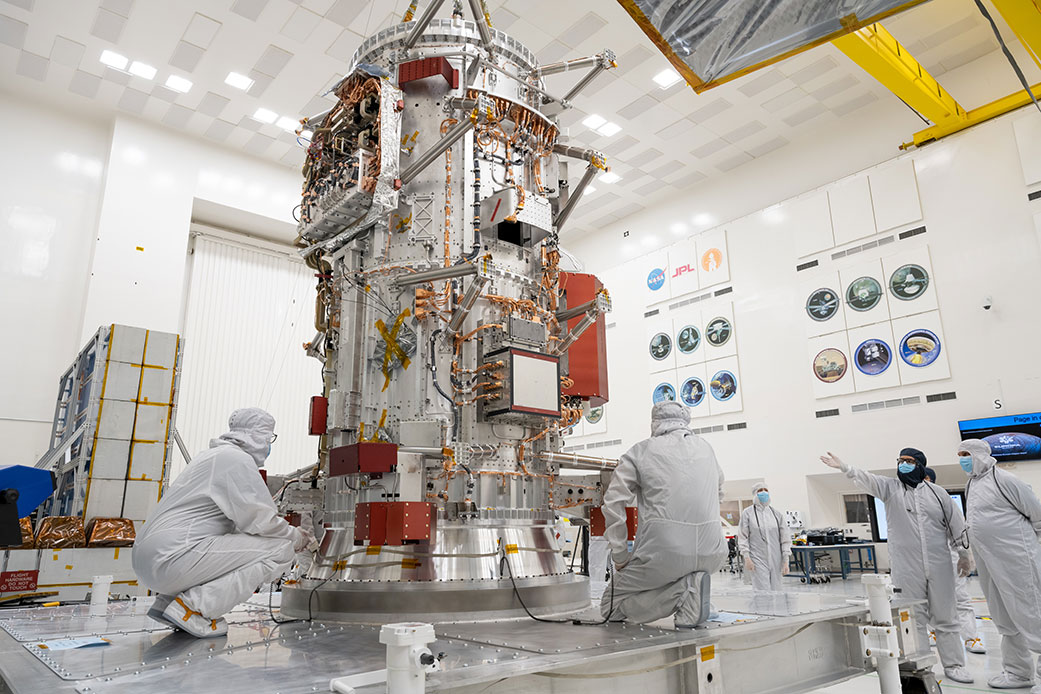
The odds are very slim that you’ll ever get inside the room known as High Bay 1 at NASA and Caltech’s Jet Propulsion Laboratory in Pasadena, Calif. If by some chance you did get inside, you certainly couldn’t just walk in as you are. First, you’d enter an anteroom where automated brushes would be applied to your shoes to remove any loose dirt or particles; next you’d stand under an air shower that would blow lint, dirt, and any other stray debris from your clothes. Following that you’d move to a robing room where you’d stand on a sticky mat to ensure the bottom of your shoes were clean as well, and finally, you’d don a so-called bunny suit—robe, head cover, and, never mind how clean your shoes are by now, cloth booties.
Only then would you be allowed inside High Bay 1, a 14 m (45 ft) tall, 21 m (68 ft) wide volume of space that qualifies as a Class 10,000 clean room—meaning that there are fewer than 10,000 particles 0.5 microns or larger per cubic foot of air. (A micron is about 100 times smaller than the width of a human hair.) But it would be worth the scrubbing down to enter the storied room, especially this week—since, as NASA reports, the main body of the new spacecraft known as the Europa Clipper was just rolled into place for assembly and testing in preparation for its 2024 launch.
Weighing in at 6,000 kg (13,000 lbs) and measuring 3 m (10 ft) tall and 1.5 m (5 ft) across, the Europa Clipper will be launched aboard a Falcon Heavy rocket on a six-year, 2.8 billion km (1.8 billion mile) looping trajectory to reach what might be the most promising place in our solar system for extraterrestrial life: Jupiter’s bright white moon Europa. Measuring 90% the diameter of our moon, Europa is covered by a shell of water ice 15 to 25 km (10 to 15 mi) thick, capping a warm, globe-girdling ocean up to 150 km (100 mi) deep. That single Europan ocean holds twice as much water as all of the Earth’s oceans combined—and Europa Clipper is built to learn more about it.
The spacecraft will not land on Europa, but is designed to make at least 50 close-up flybys of the moon, using a suite of instruments to take its chemical and geological measure. Among the on-board hardware are a plasma sensor to take magnetic soundings of the surface and subsurface; a wide-angle, high-resolution camera; a thermal emission system; and an ultraviolet spectrograph. All of that equipment and more will be painstakingly installed in the spacecraft over the course of the next two years, and the scene in High Bay 1 today is an intensely focused, intensely busy one. A heavy vault is currently being bolted into place on the spacecraft to protect the delicate instruments from the intense radiation field that surrounds Jupiter; propulsion tanks that will feed fuel to 24 on-board thrusters are being attached; and nearly 640 m (2,100 ft) of bright copper cabling—enough to wrap twice around a football field—is being threaded inside the body of the ship.
The work will not come cheap: the Europa Clipper mission will set NASA back at least $4.25 billion in design, construction, and operation costs. But the space community—especially the biologists who specialize in studying the possibility of extraterrestrial life—believe it will be more than worth it. The rule for life—at least life as we know it—has always been follow the water. That’s what gave rise to life on Earth—and that’s what might have given rise to life on Europa too. Answers—or at least clues—to that epochal question could be coming soon, and it is in High Bay 1 that the work to find them got underway in earnest this week.
This story originally appeared in TIME Space, our weekly newsletter covering all things space. You can sign up here.
More Must-Reads from TIME
- Cybersecurity Experts Are Sounding the Alarm on DOGE
- Meet the 2025 Women of the Year
- The Harsh Truth About Disability Inclusion
- Why Do More Young Adults Have Cancer?
- Colman Domingo Leads With Radical Love
- How to Get Better at Doing Things Alone
- Michelle Zauner Stares Down the Darkness
Write to Jeffrey Kluger at jeffrey.kluger@time.com